tire size AUDI S6 2013 Owners Manual
[x] Cancel search | Manufacturer: AUDI, Model Year: 2013, Model line: S6, Model: AUDI S6 2013Pages: 306, PDF Size: 76.92 MB
Page 196 of 306
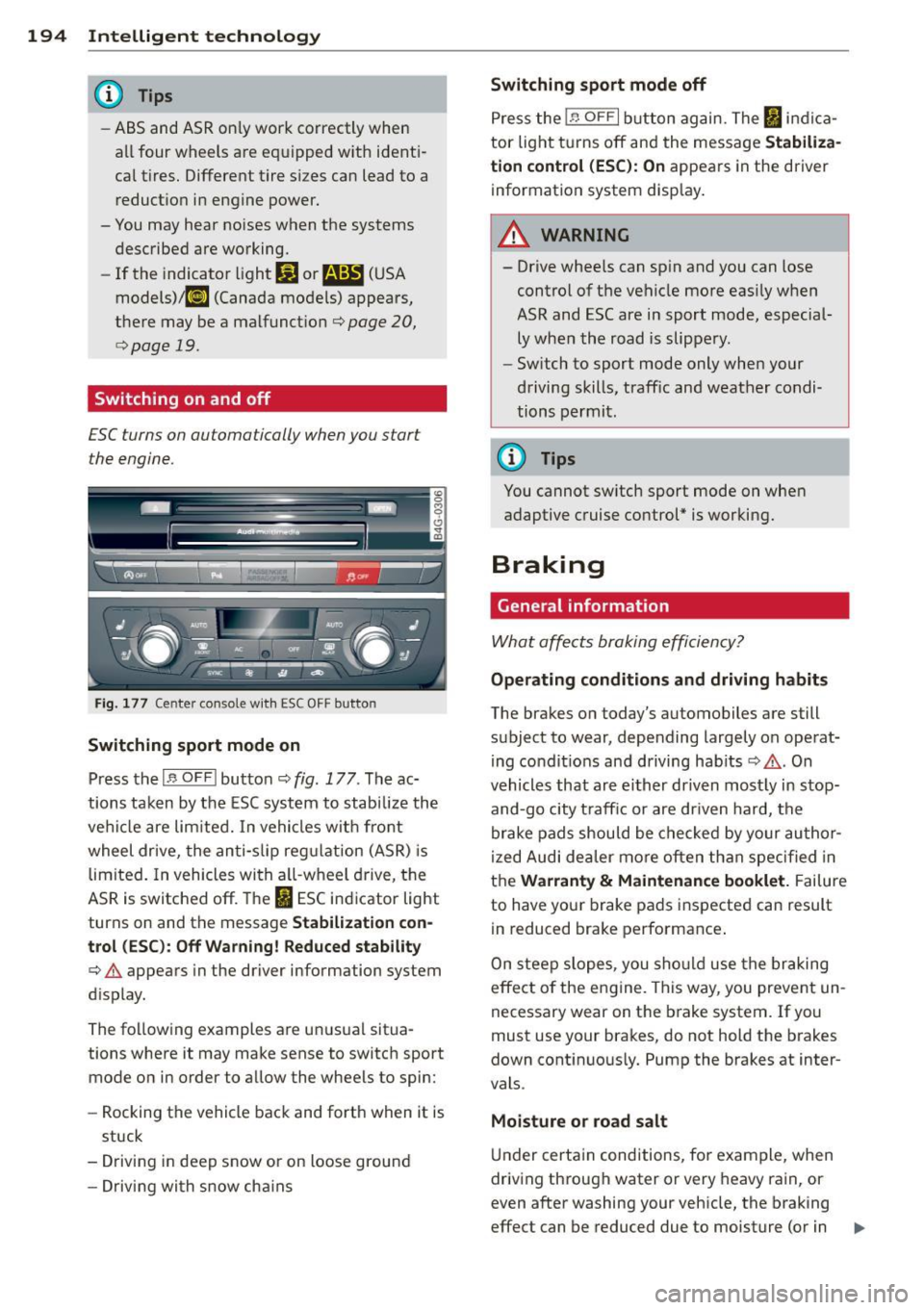
194 Intelligent technology
@ Tips
-ABS and ASR on ly work correctly when
all four wheels are equipped w ith identi
cal tires. Different tire sizes can lead to a
reduction in engine power.
- You may hear noises when the systems
described are working.
- If the indicator light
DJ or 11:11 (USA
models) 1i] (Canada models) appears,
there may be a malfunction¢
page 20,
c> page 19.
Switching on and off
ESC
turns on automatically when you start
the engine.
Fig. 177 Center console w it h ESC OFF button
Switching sport mode on
Press the I~ OF FI button c::> fig . 177. The ac
tions taken by the ESC system to stabilize the
vehicle are limited. In vehicles with front
wheel drive, the anti-slip regulation (ASR) is
limited. In vehicles with a ll-wheel drive, the
ASR is switched off. The
It) ESC indicator light
turns on and the message
Stabilization con
trol (ESC): Off Warning! Reduced stability
¢.&. appears in the driver information system
d isplay.
The following examples are unusual situa
tions where it may make sense to switch sport
mode on in order to allow the wheels to spin:
- Rocking the vehicle back and forth when it is
stuck
- Driving in deep snow or on loose ground
- Driving with snow cha ins
Switching sport mode off
Press the 1.$ OF FI button again. The I indica
tor light turns off and the message
Stabiliza
tion control (ESC): On
appears in the driver
information system display .
A WARNING
-
-Drive wheels can spin and you can lose
control of the vehicle more easily when
ASR and ESC are in sport mode, especial
ly when the road is slippery.
- Sw itch to sport mode only when your
driving skills, traffic and weather condi
tions permit.
@ Tips
You cannot sw itch sport mode on when
adaptive cruise control* is working.
Braking
General information
What affects braking efficiency?
-
Operating conditions and driving habits
The brakes on today's automobiles are still
subject to wear, depending largely on operat
ing condit ions and driving hab its
c::> .&. . On
vehicles that are either driven most ly in stop
and-go city t raff ic or are driven hard, the
brake pads should be checked by your author
ized Audi dea ler more often than specified in
the
Warranty & Maintenance booklet. Failure
to have your brake pads inspected can result
in reduced brake performance .
On steep slopes, you should use the braking
effect of the engine . This way, you prevent un
necessary wear on the brake system. If you
must use your brakes, do not hold the brakes
down continuously. Pump the brakes at inter
vals .
Moisture o r road salt
Under certain conditions, for example, when
driving through water or very heavy rain, or
even after washing your vehicle, the braking
effect can be reduced due to moisture (or in .,,_
Page 244 of 306
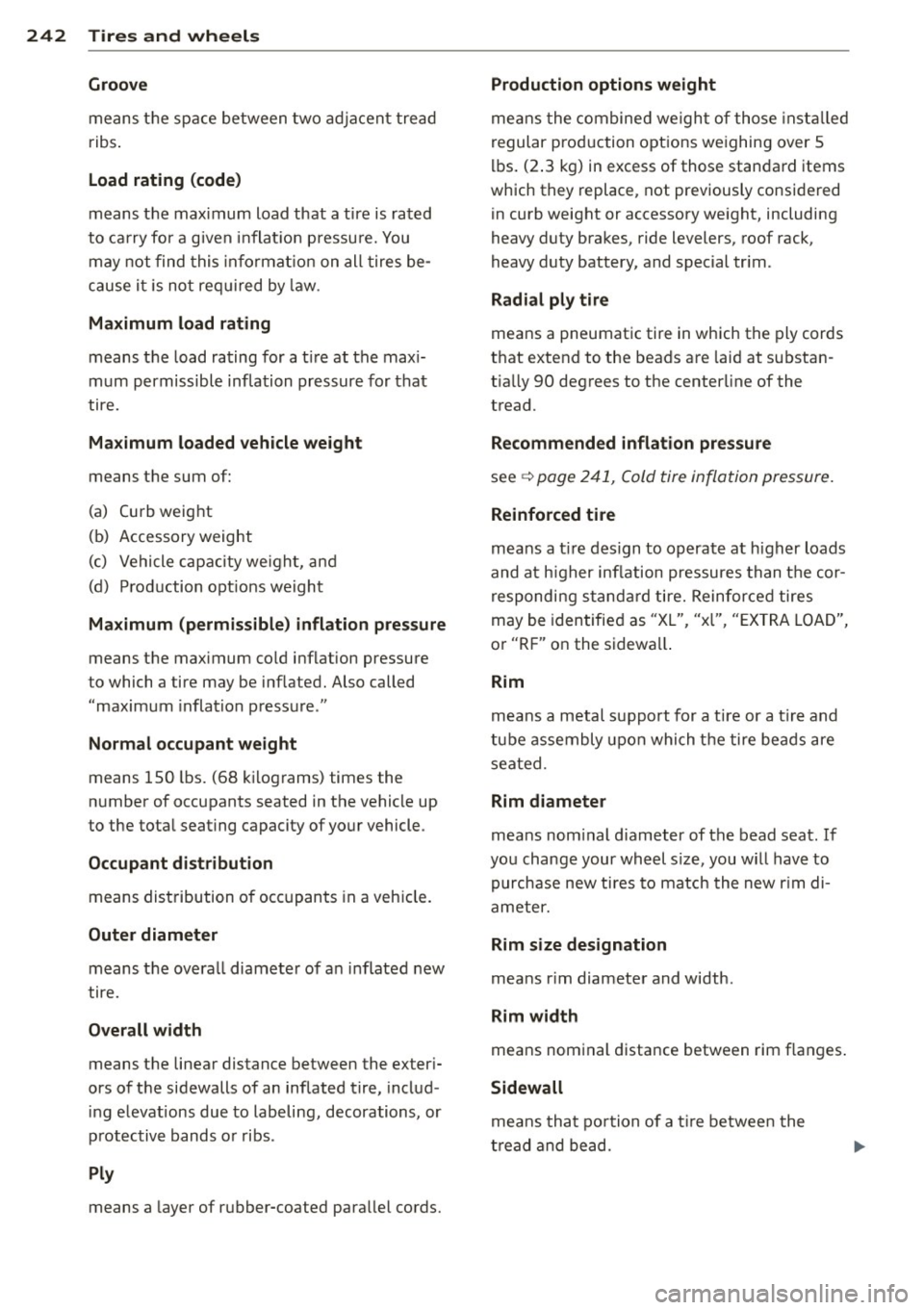
242 Tire s and wheels
Groove
means the space between two adjacent tread
ribs .
Load rating (code)
means the maximum load that a tire is rated
to carry for a given inflation pressure. You
may not find this informat ion on all tires be
cause it is not req uired by law.
Maximum load rating
means the load rating for a t ire at the max i
mum permissible inflation pressure for that
tire.
Maximum loaded vehicle weight
means the sum of:
(a) Curb weight
(b) Accessory weight
(c) Vehicle capacity we ight, and
(d) Production options weight
Maximum (permissible) inflation pressure
means the maximum cold inflation pressure
to which a tire may be inflated. Also called
"maximum inflation pressure ."
Normal occupant weight
means 150 lbs. (68 kilograms) times the
number of occupants seated in the vehicle up
to the total seating capacity of your vehicle .
Occupant distribution
means distribution of occupants in a vehicle.
Outer diameter
means the overa ll diameter of an inflated new
tire.
Overall width
means the linear distance between the exteri
ors of the sidewalls of an inflated tire, includ
ing elevations due to labeling, decorations, or
protective bands o r ribs .
Ply
means a layer of rubber-coated parallel cords.
Production options weight
means the combined weight of those insta lled
regular production options weighing over 5
lbs. (2.3 kg) in excess of those standard items
which they replace, not previously considered
in curb weight or accessory we ight, including
heavy duty brakes, ride levelers, roof rack,
heavy duty battery, and special tr im .
Radial ply tire
means a pneumat ic tire in which the ply cords
that extend to the beads are laid at substan
t ia lly 90 degrees to the center line of the
tread .
Recommended inflation pressure
see<=> page 241, Cold tire inflation pressure.
Reinforced tire
means a t ire design to operate at higher loads
and at h igher inflation pressures than the cor
responding standa rd tire. Reinforced tires
may be identified as "XL" "xl" "EXTRA LOAD"
' ' '
or "RF" on the sidewa ll.
Rim
means a metal support for a tire or a tire and
tube assembly upon which the tire beads are
seated.
Rim diameter
means nom inal d iameter of the bead seat. If
you change your wheel s ize, you will have to
purchase new tires to match the new rim di
ameter.
Rim size designation
means r im diameter and width .
Rim width
means nominal distance between rim flanges.
Sidewall
means that portion of a tire between the
t read and bead.
Page 246 of 306
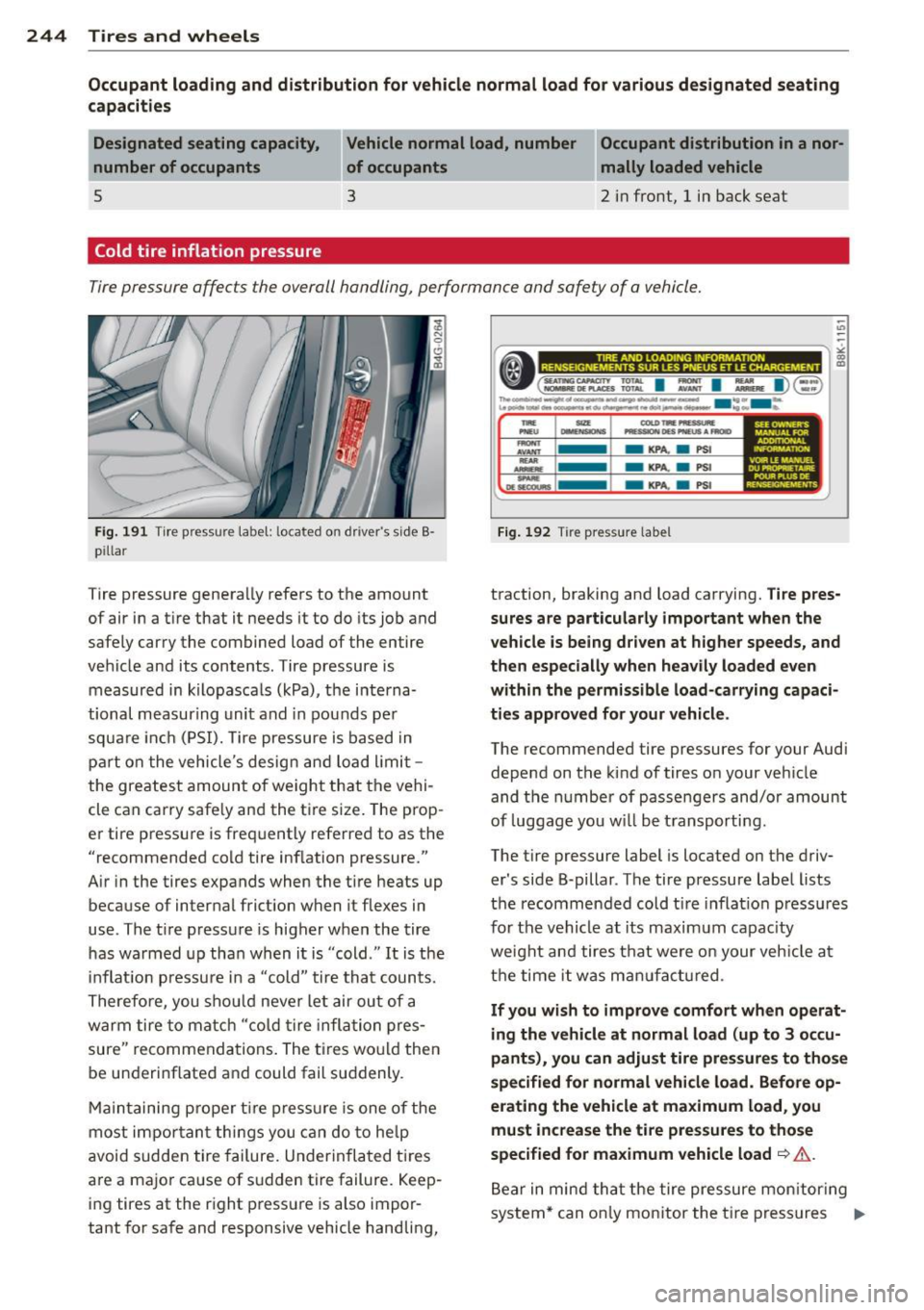
244 Tires and wheels
Occupant loading and distribution for vehicle normal load for various designated seating
capacities
Designated seating capacity,
number of occupants Vehicle normal load
, number Occupant distribution in a nor-
of occupants _____ mally loaded vehicle
5 3 2 in fro nt, 1 in back seat
Cold tire inflation pressure
Tire pressure affec ts the overall handling , performance and safe ty of a vehicle.
Fi g. 19 1 T ire p ress ure la b el: loca ted on driver's side B ·
p ill ar
Tire pressure genera lly refers to the amount
of air in a t ire that it needs it to do its job and
safely carry the combined load of the entire
vehicle and its contents . Tire pressure is
measured in kilopasca ls (kPa), the i nterna·
tional measur ing unit and in pou nds pe r
squa re inc h (PSI). Tire pressure is based in
par t on the vehicle's desig n and load limit -
the greatest amoun t of weight that the vehi·
cle can carry safe ly and the t ire size . The prop·
er tire pressure is freq uently referred to as the
" recommended cold tire inf lation pressure."
A ir in the tires expands when the tire heats up
because of internal frict ion when it flexes in
use . The t ire p ressu re is higher when the tire
h as wa rmed up tha n when it is "cold ." It is the
in flat io n pressu re i n a "cold" tire that counts.
Th erefore, you shou ld neve r let air ou t of a
warm tire to match " co ld tire inflat ion pres
sure" recommendations . The t ires wo uld then
be underinflated and could fail su ddenly .
M ain taining p roper t ire pr essu re is one of the
most im po rt an t th ings you ca n d o to he lp
avoid sudden tire failure. Underin fla ted t ires
a re a ma jo r cause of s udden tire failure. Keep·
i n g tires at the right pressure is also impor
tant for safe and responsive vehicle handling,
-U'>
-
---------------------- ,;
•(=~= I: I::... 1)§ :l!: n-...,....,....,~ ...... ~-...,..., ..... _ ... U ........ ~-·~N.-..-.we..... .... lllt-
-AVANT ...,.
-...... .. _
-KPA. a PSI
- KPA.
a PSI
-KPA. a PSI
Fig. 192 Ti re pr essure labe l
SEE OWNEJICS MANUA1 FOA A,DOITl<>N.IU. INfORMATlON VOIR L£ MANUll DUPR0ftlET""" P"OUR i-t.US DE RENSEIGMEMENfS
traction, braking and load carrying. Tire pres
sures are particularly important when the
vehicle is being driven at higher speeds, and
then especially when heavily loaded even
within the permissible load-carrying capaci
ties approved for your vehicle .
The recommended tire pressures f or y our Audi
depe nd on the kind of tires o n your ve hicle
and the numbe r of passe ngers and/o r amount
of luggage you w ill be t ransporti ng .
The tire pressure label is located on the driv
er 's side B-pillar . The tire pressure labe l lists
the recommended cold t ire inflat io n press ures
for the vehicle at its maximum capac ity
weig ht an d tires t hat were o n your veh icle at
t h e time it was m anufactur ed .
If you wish to improve comfort wh en operat
ing the vehicle at normal load (up to 3 occu
pant s), you can ad just tire pre ssure s to tho se
specified for normal vehicle load . Before op
erating the vehicle at maximum load, you
mu st increase the ti re pressures to those
specified for maximum vehicle load
~ ,&. .
Bear in min d that the tire pressure mon itor ing
system * can o nly mo nitor the tir e press ures .,.
Page 247 of 306
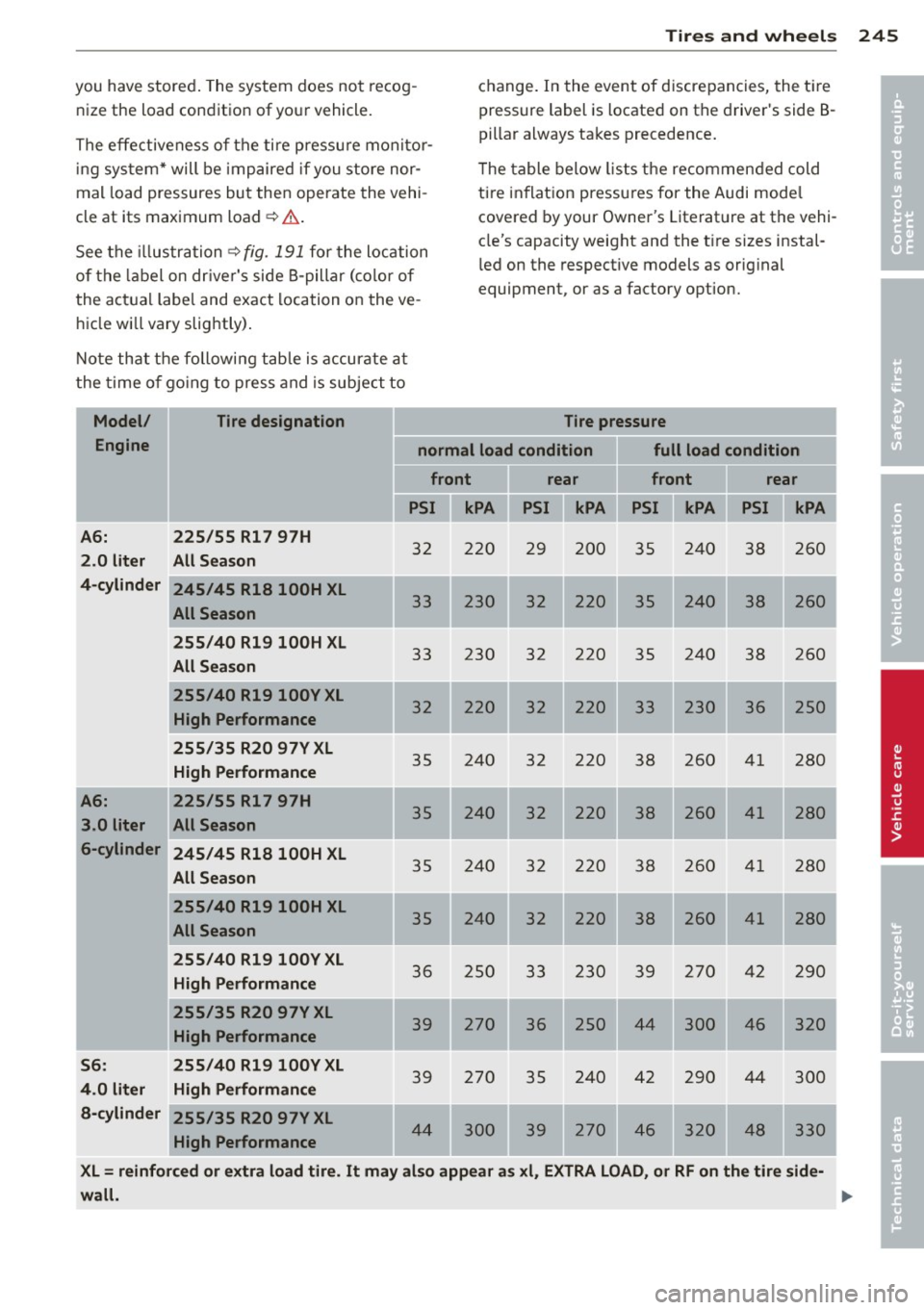
Tires an d wheel s 245
you have stored. The system does not recog
nize the load condition of your vehicle.
The effectiveness of the ti re pressu re monitor
ing sys tem* will be impaired if you store nor
mal load pressures but then operate the vehi
cle at its maximum load¢,& .
See the illustration ¢
fig. 191 for the location
of the label on dr iver's side B-pillar (co lor of
the actual labe l and exact location on the ve
hicle wi ll vary slig htly) .
Note that the fo llowing tab le is accurate a t
the t ime o f go ing to press and is subject to
I Model / II Tire de signation
c h ange. In the event of discrepancies, the ti re
pressure label is located on the driver's side B
pillar always takes precedence .
T he table below lists the recommended cold
ti re inflat ion pressures for the Audi mode l
covered by your Owner's Literat ure at the vehi
cle's capacity weight and the t ire sizes instal
l ed on the respective models as orig inal
equipment, or as a factory option.
Tire pressure
Engine normal load condition full load condition
A6: 2 .0 lit er
4 -cylinder
A6: 3.0 liter
-
225 /5 5 Rl 7 97H
All Season
245 /45 Rl8 l0OH XL
All Season
255 /40 Rl 9 l00H XL
All S eason
255 /40 Rl9 l0OY XL
High Performance
255 /35 R20 97Y XL
High Perfo rmance
225 /55 Rl 7 97H
All Season
6-cylinder 245 /45 Rl8 l00H XL
All Seaso n
255 /40 Rl9 l0OH XL
All Season
255 /40 Rl9100Y XL
High Performance
255 /35 R20 97V XL
High Performance
S6: 255 /40 Rl 9100YXL
4.0
liter High P erformance
a -cy lind er
255 /35 R20 97V XL
High Performance front
PSI
ll kPA
32 220
230
33 230
32 220
35 240
35 240
35 240
35 240
36 250
39 270
39 270
44 300
rear front rear
PSI
ll kPA PSI ll kPA PSI ll kPA
29 200 35 240 38 260
32 220 35 240
38 260
32 220 35 240
38 260
32 220 33 230 36 250
32 220 38 260 41 280
32 220 38 260 41 280
32 220 38 260 41 280
32 220 38 260 41 280
33 230 39 270 42 290
36 250 44 300 46 320
35 240 42 290 44 300
39 270 46 320 48 330
XL= reinfor ced or extra load tire . It may al so appear a s xl , EXTRA LOAD , or RF on the tire side-
'
I
l
J
•
I
wall. ..,.
•
•
Page 248 of 306
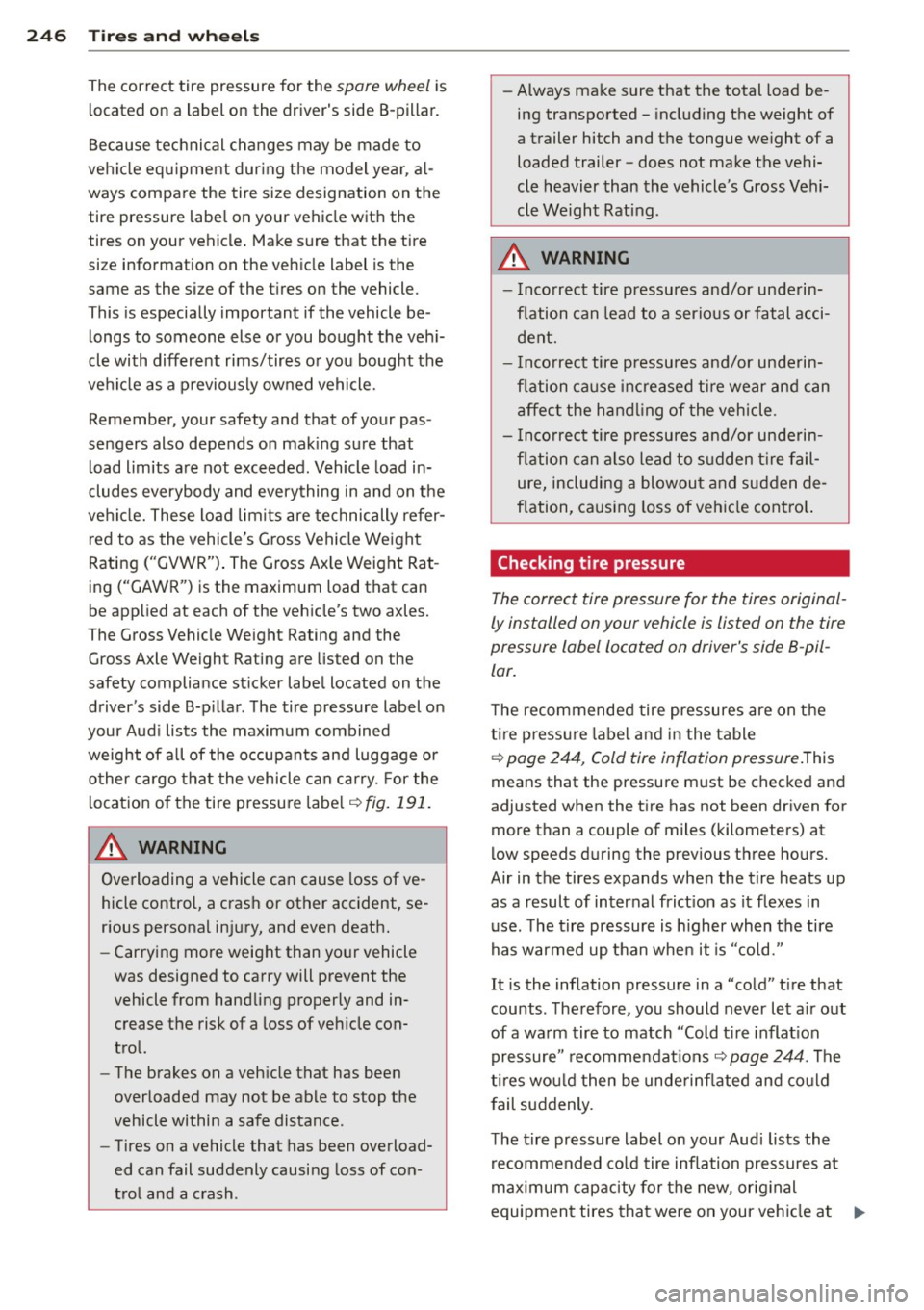
24 6 T ire s and whee ls
The correct tire pressure for the spare wheel is
located on a label on the driver's side B-pillar.
Because tec hnical changes may be made to
vehicle equ ipment dur ing the model year, a l
ways compare the tire size designation on the
tire pressure labe l on your vehicle with the
tires on your vehicle . Make sure that the tire
si ze information on the vehicle label is the
same as the si ze of the tires on the vehicle.
This is especially important if the vehicle be
longs to someone else or you bought the veh i
cle with different rims/tires or you bought the
vehicle as a p reviously owned vehicle.
Remember, your safety and that of your pas
sengers also depends on mak ing sure that
l oad limits are not exceeded. Vehicle load in
cludes everybody and everything in and on the
ve hicl e. These load limits are technically refer
red to as the vehicle's Gross Vehicle Weight
Rating ("GVWR") . The Gross Ax le Weight Rat
ing ("GAWR") is the maximum load that can
be applied at each of the veh icle's two axles.
The Gross Vehicle Weight Rating and the
Gross Axle Weight Rating are listed on the
safety compliance st icker labe l located on the
driver 's side B-p illar . The tire pressure label on
your Aud i lists the maximum combined
weight of all of the occupants and luggage or
o ther cargo that the vehicle can carry. For the
l ocation of the tire pressu re labe l
i=:> fig. 191.
A WARNING
Overloading a vehicle can cause loss of ve
hicle control, a cras h or other accident, se
r ious personal injury, and even death.
- Carrying more weight than yo ur vehicle
was designed to carry will prevent the
vehicle from handling properly and in
crease the risk of a loss of veh icle con
trol.
- The brakes on a veh icle that has been
overloaded may not be able to stop the
vehicle within a safe distance.
- Tires on a vehicle that has been overload
ed can fail suddenly causing loss of con
trol and a crash . -
Always make sure that the total load be
ing transported - including the weight of
a trailer hitch and the tongue we ight of a
loaded trailer -does not make the vehi
cle heavier than the vehicle's G ross Vehi
cle Weight Rating.
A WARNING
-- I ncorrect tire pressures and/or underin-
flation can lead to a serious or fatal acci
dent.
- I nco rrect tire pressures and/or underin
flation cause increased ti re wear and can
affec t the handling of the vehicle .
- I nco rrect tire pressures and/or underin
flation can a lso lead to s udden t ire fail
ure, including a blowou t and sudden de
flation, ca using loss of veh icle cont ro l.
Checking tire pressure
The correct tire pressure for the tires original
ly installed on your vehicle is listed on the tire
pressur e label located on driver's side 8-pil
lar .
The recommended tire pressures are on the
t ir e pressure label and in the table
i=:> page 244, Cold tire inflation pressure.This
means that the pressure m ust be checked and
adjusted when the t ire has not been dr iven for
more than a couple of miles (kilometers) at
low speeds during the previous three hours.
Air in the tires expands when the tire heats up as a result of inter nal frict ion as it flexes in
u se . T he t ire pressure is higher when the tire
has warmed up t han whe n it is "co ld. "
It is the inflation pressure in a "co ld" t ire that
counts . The refore, you should never let a ir out
of a wa rm tire to match "Cold t ire inflat ion
pressure" recomme ndat ions
i=:, page 244 . The
t ir es wo uld then be unde rinflated and co uld
fail suddenly .
T he t ire pressure label on your Audi lists the
recommended co ld tire inflation pressures at
m aximum cap acity for the new, or ig inal
equipmen t tires tha t were on your vehicle at ..,.
Page 253 of 306
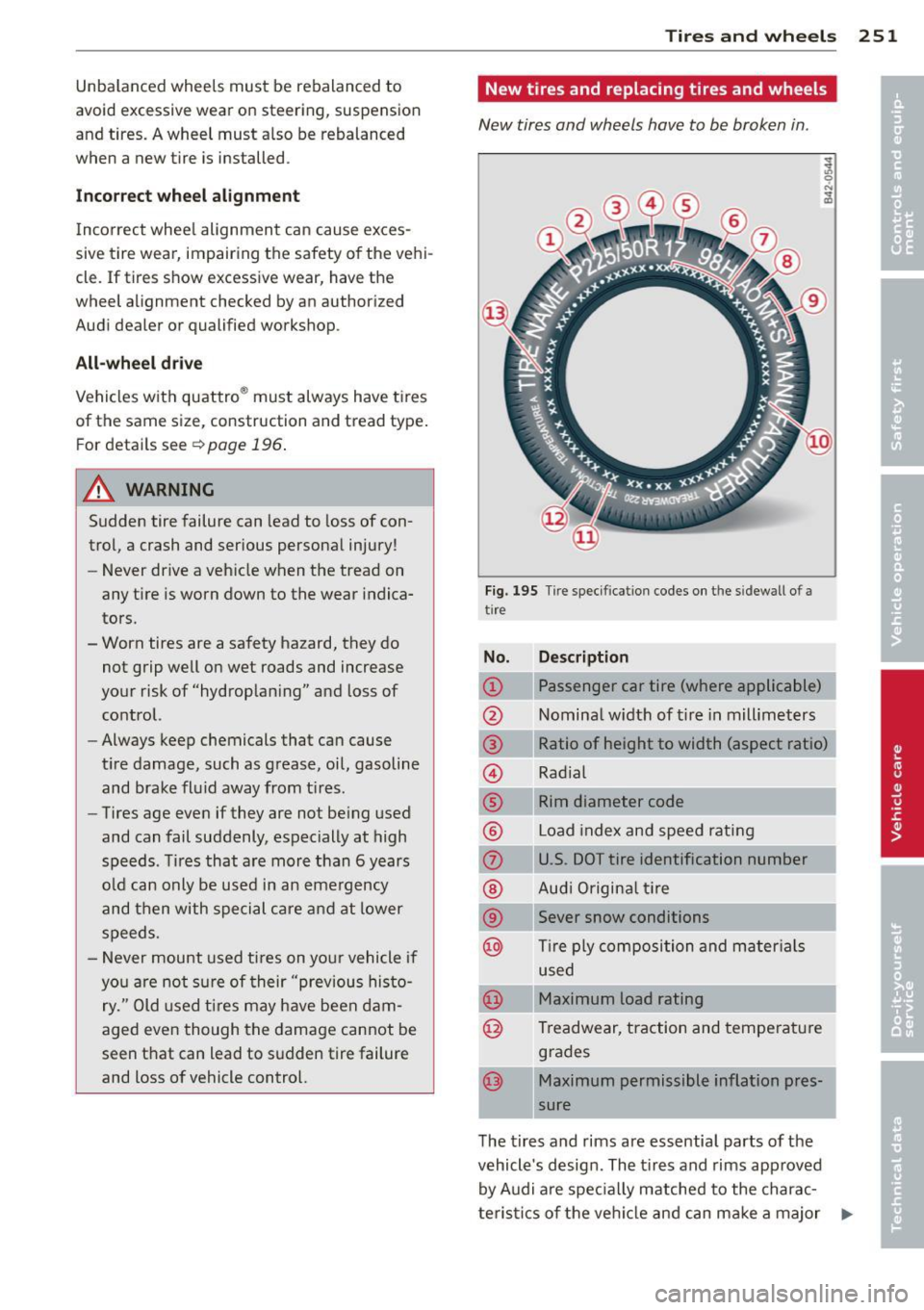
Unbalanced whee ls must be rebalanced to
avoid excessive wea r on steering, suspension
and tires. A wheel must a lso be rebalanced
when a new tire is installed .
Incorrect wheel alignment
Incorrect whee l alignment can cause exces
sive tire wear, impairing the safety o f the vehi
cle. If tires show excess ive wear, have the
wheel alignment checked by an authorized
Audi dealer or qualified workshop .
All-wheel d rive
Vehicles w ith quattro ® must always have tires
of the same size, construction and tread type .
F or detai ls see
r=!:> page 196 .
A WARNING
Sudden tire failure can lead to loss of con
trol, a crash and serious persona l injury!
- Never drive a veh icle when the tread on
any tire is worn down to the wear indica
tors.
- Worn tires are a safety hazard, they do not grip well on wet roads and increase
your risk of"hydrop lan ing" and loss of
co ntrol.
- Always keep chemicals that can cause
tire damage, such as grease, oil , gasoline
and brake fluid away from t ires.
- Tires age eve n if they are not be ing used
and can fail suddenly, especially at high
speeds. T ires that are more than 6 years
o ld can only be used in an emergency
and then with spe cial care a nd at lower
s peeds.
- Never mount used ti res on yo ur vehicle if
yo u a re not s ure of their "prev ious histo
ry." Old used ti res may have been dam
aged even though the damage cannot be
seen that can lead to s udden tire failure
and loss of vehicle control. Tires and wheels 251
New tires and replacing tires and wheels
New tires and wheels have to be broken in
.
Fig. 19 5 Tir e spec ificat io n codes on t he s idewall o f a
tire
No. De sc ription
CD Passenger car tire (where applicable)
@ Nomina l w idth of t ire in mill imeters
® Ratio of height to width (aspect ratio)
© Rad ial
® Rim diameter code
® Load index and speed rating
(f) U.S. DOT tire identification number
® Aud i Origina l tire
® Sever snow conditions
@ T ire ply composition and mater ials
used
@ Maximum load rating
@ Treadwear, traction and temperat ure
grades
@ Maximum permissible inflation pres-
sure
T he tires and rims are essential parts o f the
vehicle's design . The ti res and rims app roved
by Audi a re spec ia lly matched to the charac
teris tic s of the ve hicl e and can m ake a major .,.
•
Page 255 of 306
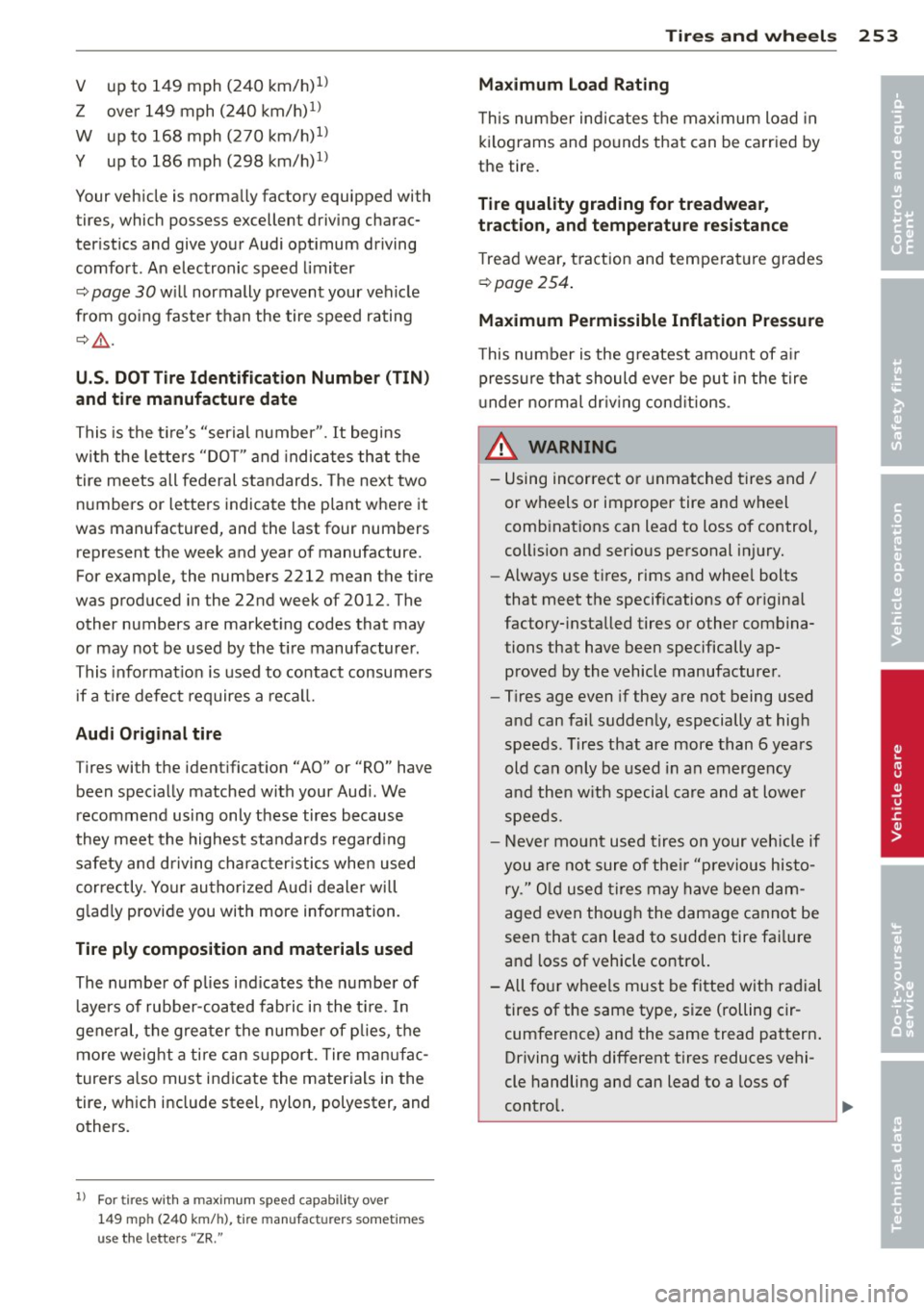
V up to 149 mph (240 km/h)1
)
Z over 149 mph (240 km/h)1)
W up to 168 mph (270 km/h)1l
Y up to 186 mph (298 km/h)
1 )
Your veh icle is norma lly factory equipped with
t ires, which posses s excellen t driving charac
ter istics and give your Audi opt imum driving
comfort . An electronic speed limiter
~ page 30 w ill normally prevent your vehicle
from go ing faste r th an the tire speed rating
~ &. -
U.S. DOT T ire Identification Number (TIN )
and tire manufactur e date
This is the t ire's "serial numbe r" . It begins
with the le tters "DOT" and indicates that the
tire meets all federal standards . The next two
numbers or letters indicate the p lant where it
was manufactured, and the last four numbers represent the week and year of manufactu re.
Fo r example, the numbers 2212 mean the tire
was produced in the 22nd week of 2012. The
other numbers are market ing codes that may
or may not be used by the t ire manufacturer.
This informat ion is used to contact consumers
if a t ire defect requires a reca ll.
Audi Original tire
Tires with the iden tifica tion "AO" or "RO" have
been spec ially matched with your Aud i. We
recommend using only these tires because
they meet the highest standards regard ing
safety and d riving charac ter istics when used
correctly . Yo ur au thori zed Audi dealer w ill
g lad ly provide you with more information.
Tire ply composition and materials used
The numbe r of p lies ind icates the n umber of
l ayers of rubber-coated fabric i n the t ire. In
gener al, the grea ter the numbe r of p lies, the
more weig ht a tire can s upport. Tire man ufac
turers a lso must indicate the materials in the
tire, wh ich include ste el, nylon, polyest er, and
others.
ll Fo r tires wit h a m ax im um s pee d ca pabil ity over
1 4 9 m ph (24 0 k m/h) , tire m an ufa ctur ers somet ime s
use the let ters "ZR."
Tire s an d wheel s 253
Maximum Load Rating
This number indicates the max imum load in
k ilograms and po unds t hat can be ca rr ied by
the tire.
Tire quality grading for treadwear ,
traction, and temp eratu re resistance
T read wear, t raction and tempe ra tu re grades
¢ page
254 .
Maximum Permissible Inflation Pressure
This number is the greatest amount of a ir
pressure that should ever be put in the tire
u nder norma l dr iv ing cond itions .
_& WARNING ~
- Using incorrect o r unmatched tires and I
or wheels or improper tire and wheel
comb inat ions can lead to loss of control,
coll is ion and serious personal in jury.
- Always use t ires , rims and whee l bolts
that meet the specif ications of original
factory- installed tires or other combina
tions that have been sp ecifically ap
proved by the vehicle manufacture r.
- Tires age even if they are not being used
and can fai l sudden ly, especially at high
speeds . Tires that are more than 6 yea rs
old can only be used in an emergency
and then w ith special care and at lower
speeds.
- Never mo unt used tires on your veh icle if
you are not sure of the ir "previous histo
ry ." O ld used tires may have been dam
aged even though the damage cannot be
seen that can lead to sudden tire fai lure
and loss of vehicle control.
-All four whee ls must be fitted with radial
tires of the same type, size (rolling cir cumference) and the same tread pattern .
Driving with different tires reduces vehi
cle handling and can lead to a loss of
control.
•
•
Page 257 of 306
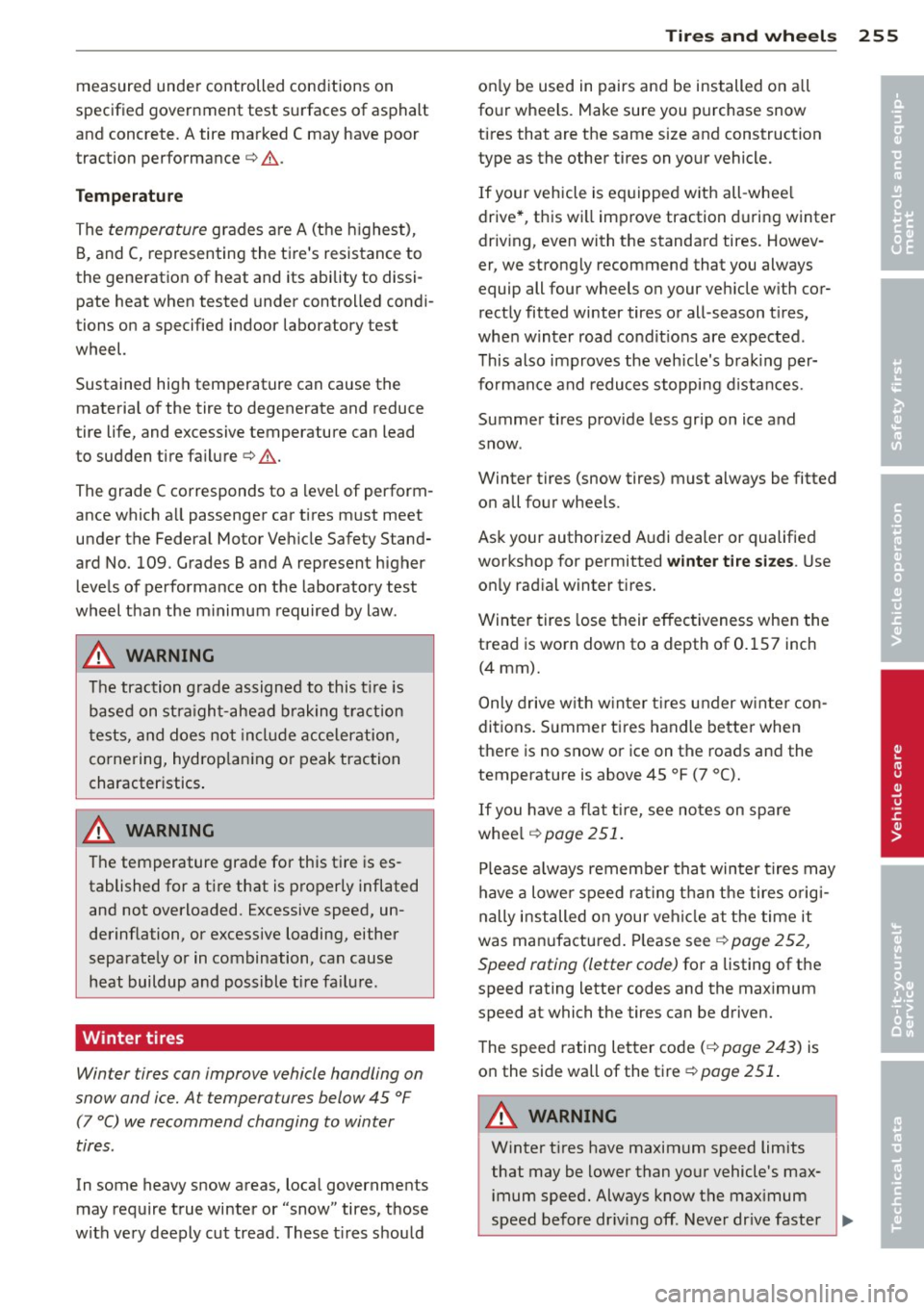
measured under controlled conditions on
specified government test surfaces of asphalt
and concrete. A tire marked C may have poor
traction performance
c::> & .
Temp erature
The temperature grades a re A (the highest),
B, and C , representing the tire's resistance to
the generation of heat and its ability to dissi pate heat when tested under controlled condi
tions on a specified indoor laboratory test
wheel.
Sustained high temperature can cause the materia l of the tire to degenerate and reduce
tire life, and excessive temperature can lead
to sudden tire fa ilure
c::> & .
The grade C corresponds to a level of perform
ance which a ll passenger car tires must meet
under the Federal Motor Veh icle Safety Stand
ard No.
109. Grades Band A represent higher
levels of performance on the laboratory test
wheel than the m inimum required by law .
&, WARNING
The traction grade assigned to this t ire is
based on stra ight-ahead b raking traction
tests, and does not include acceleration,
cornering, hydrop lan ing or peak traction
character istics .
A WARNING
The temperature grade for this tire is es
tablished for a tire that is properly inflated
and not overloaded . Excessive speed, un
derinflation, or excessive loading, either
separate ly or in combination, can cause
heat buildup and possible tire fa ilure.
Winter tires
Win ter tires can improve vehicle handling on
snow and ice. At tempera tures below 45 °F
(7 °C) we recommend changing to winter
tires.
In some heavy snow areas, loca l governments
may require true winter or "snow" tires, those
with very deeply cut tread. These t ires should
Tire s an d wheel s 255
only be used in pairs and be installed on all
fo ur wheels. Make sure you purchase snow
tires that are the same size and construction
type as the other tires on your vehicle.
If your vehicle is eq uipped w ith all -whee l
drive*, this wi ll improve traction during winter
driv ing, even with the standard tires. Howev
er, we strongly recommend that you always equip all four wheels on your veh icle w ith cor
rect ly fitted winter tires o r all -season t ires,
whe n w inter road cond it ions are expected.
T his also improves the veh icle's brak ing per
fo rmance and redu ces stoppi ng d istances.
Summer tires provide less grip on ice and
snow .
Winter tires (snow tires) must always be fitted
on all four wheels.
Ask your authorized A udi dealer or qualified
workshop for permitted
wi nter ti re size s. Use
on ly rad ial winter t ires.
Winter tires lose their effectiveness when the
tread is worn down to a depth of
0 .1 57 inch
(4 mm).
Only drive w ith w inter tires under w inter con
ditions. S umme r tires handle better when
there is no snow or ice on the roads and the
temperature is above 45
°F (7 ° ().
If you have a flat tire, see no tes on spare
whee l c::> page 251.
Please a lways remember that winter tires may
have a lowe r speed ra ting than the tires o rig i
nally installed on your veh icle at the time it
was man ufactured. P lease see
c::> pag e 252,
Speed rating (letter code) for a listing of the
speed rating letter codes and the max imum
speed at which the tires can be driven.
The speed rating le tter code
(c::> page 243) is
on the side wall of the tire
c::> page 251 .
A WARNING
Winter t ires have maximum speed limits
that may be lower than yo ur vehicle's max
imum speed. Always know the max imum
speed before dr iv ing off . Never dr ive faster
~
•
•
Page 258 of 306
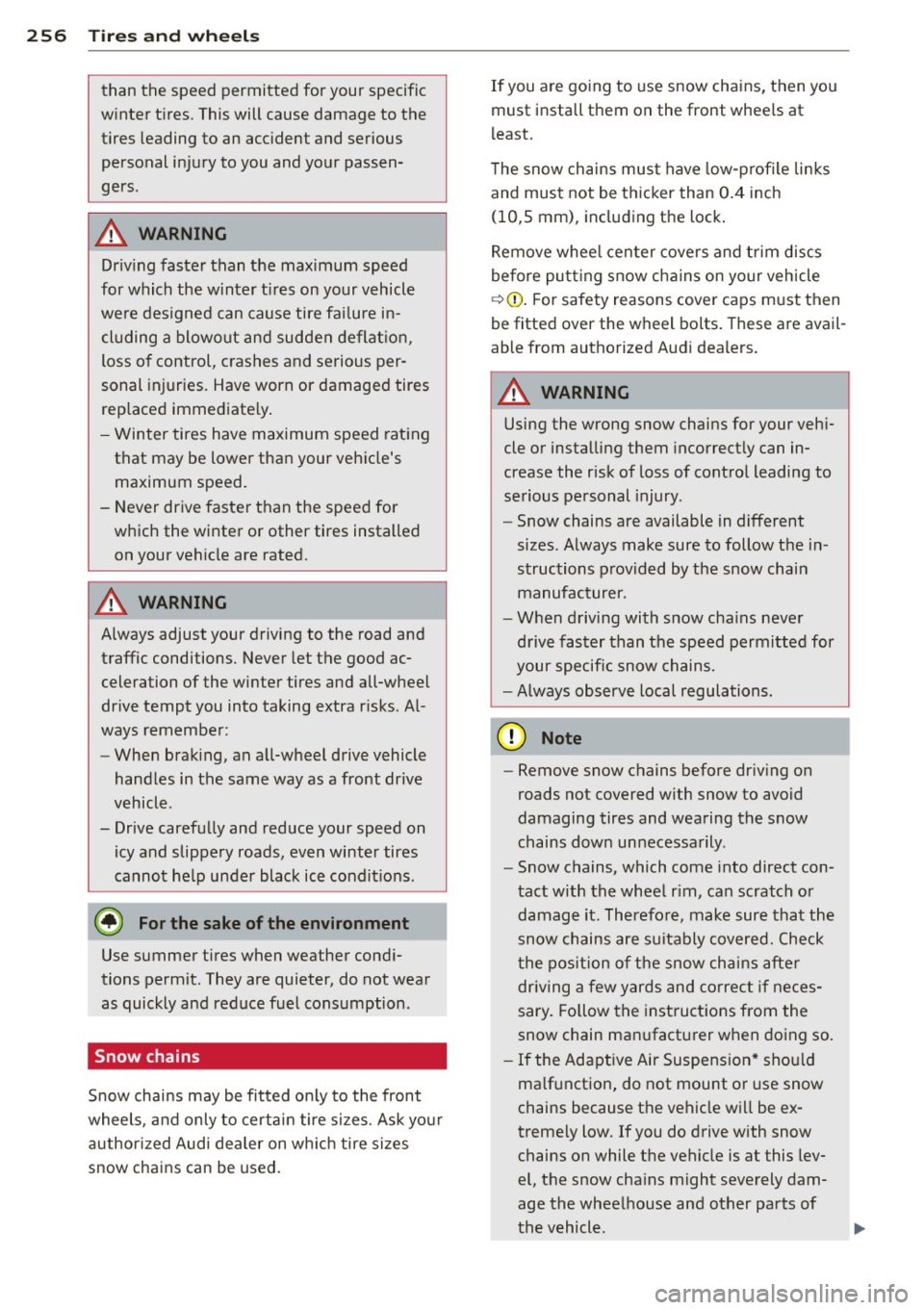
256 Tire s and wheel s
than the speed permitted for your specific
w inter t ires. This will cause damage to the
tires leading to an accident and serious
pe rsonal injury to you and your passen
gers .
A WARNING
Driv ing faster than the maximum speed
for which the w inte r tires on your vehicle
we re designed can cause tire fai lu re in
cl uding a blowout and sudden deflat ion,
loss of control, c rashes and serious per
sonal injuries. Have worn or damage d tires
rep laced immediate ly .
- Winter tires have maximum speed rat ing
that may be lower tha n your veh icle's
maximum speed.
- Never drive faster than the speed for
which the winter or other tires installed
on your vehicle are rated.
A WARNING
Always adjust your d riving to the road and
traffic conditions. Never let the good ac
celeration of the winter tires and all-whee l
drive tempt you into taking extra r isks. A l
ways remember :
- When brak ing, an all-w heel drive vehicle
hand les in the same way as a front drive
vehicle .
- Drive carefu lly and reduce your speed on
icy and slippery roads, even winte r tires
cannot he lp under black ice condit ions .
@ For the sake of the environment
Use summer tires when weather cond i
tions permit . They are quieter, do not wea r
as quickly and reduce f ue l consumption .
Snow chains
-
Snow chains may be fitted on ly to the front
wheels, and only to certa in tire sizes. Ask yo ur
author ized Audi dealer on wh ic h tire sizes
snow chains can be used.
If you are go ing to use snow chains, then you
must i nstall them on the front whee ls at
l east.
T he snow chains mus t have low-p rofile links
and must not be th icker than 0 .4 inch
(10,5 mm) , includ ing the lock .
Remove whee l cen ter covers and t rim discs
before pu tting snow c hains on your veh icle
¢ (D . For safety reasons cover caps m ust then
be fitted over the wheel bo lts. These are avail
able from autho rized Aud i dealers .
A WARNING
Using the wrong snow chains for your veh i
cle or installing them incorrect ly can in
crease the risk of loss of contro l leading to
se rious pe rsonal injury.
- Snow chains are available in different
sizes . Always make sure to follow the in
structions p rov ided by t he snow chain
manufacturer.
- W hen driving wi th s now cha ins never
d riv e faster than t he speed permitted for
your specifi c snow chains.
- Always observe local regulations.
(D Note
-Remove snow chains before dr iv ing on
roads not covered with snow to avoid
damaging tires and wea ring the snow
chains down un necessa rily.
- Snow chains, which come i nto direct con
t act with the whee l rim, can scratch or
damage it. Therefo re, make sure that the
snow chains a re s uitably covered. Check
t he pos ition o f th e snow cha ins afte r
dr iv ing a few yards and correc t if neces
sary. Follow the inst ructions from the
snow chain ma nufactu rer when do ing so .
- If the Adaptive Air Suspens ion * sho uld
ma lf u nction, do not mount or use snow
chains because the vehicle w ill be ex
treme ly low. If you do drive with snow
chains on while t he vehicle is at this lev
el, t he snow cha ins might seve rely dam
age the whee lhouse and o ther parts of
the vehicle.
Page 260 of 306
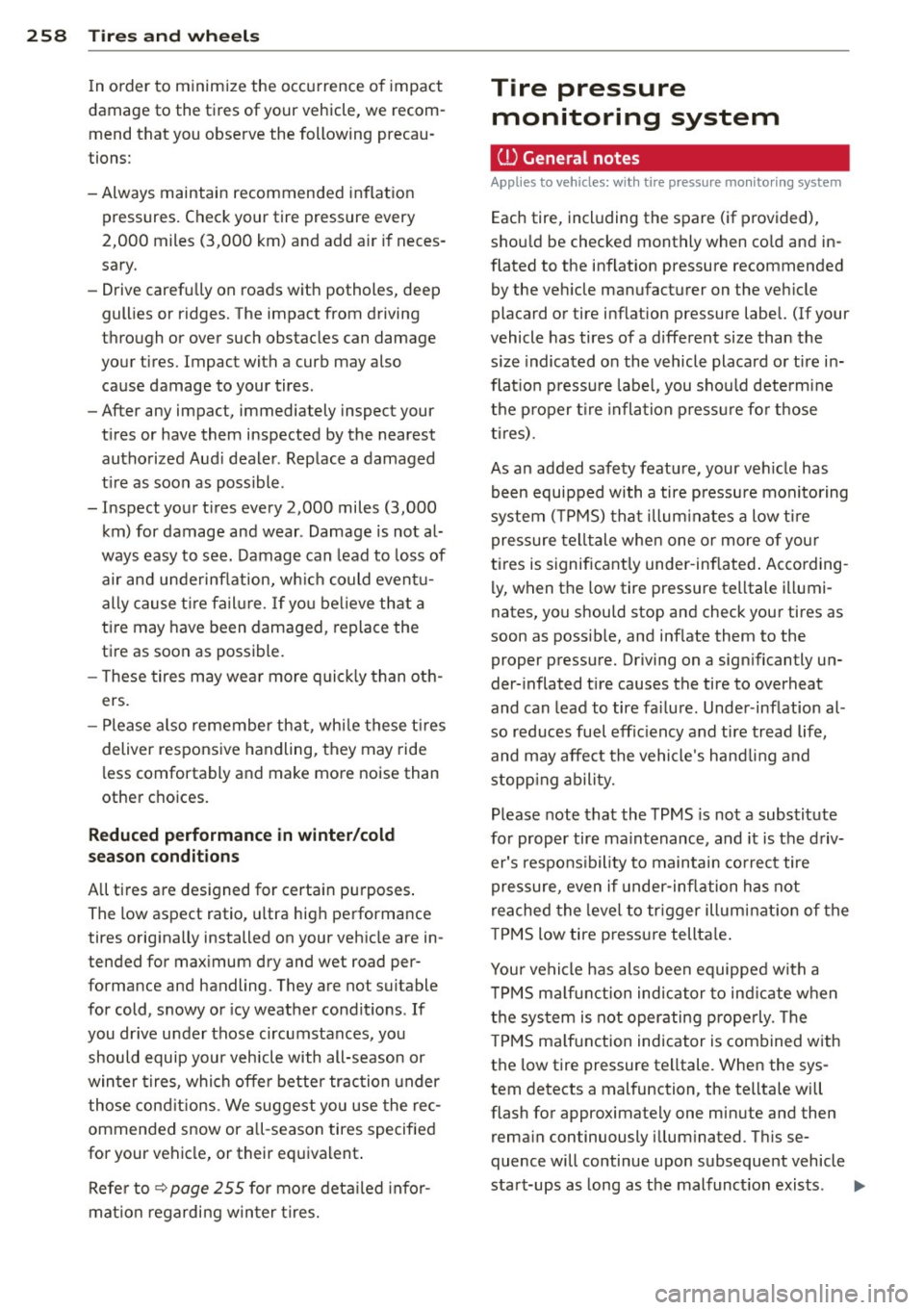
258 Tires and wheels
In order to minimize the occurrence of impact
damage to the tires of your vehicle, we recom
mend that you observe the following precau
tions :
- Always maintain recommended inflation
pressures. Check your tire pressure every
2,000 miles (3,000 km) and add a ir if neces
sary.
- Drive carefu lly on roads with potholes, deep
gullies or ridges. The impact from driving
through or over such obstacles can damage
your tires. Impact with a curb may also cause damage to your tires.
- After any impact, immediately inspect your
tires or have them inspected by the nearest
authorized Aud i dealer . Replace a damaged
t ir e as soon as possible .
- Inspect your t ires every 2,000 miles (3,000
km) for damage and wear . Damage is not al
ways easy to see. Damage can lead to loss of
air and underinflation, wh ich could event u
ally cause t ire failure.
If you believe that a
ti re may have been damaged, replace the
tire as soon as possible.
-These tires may wea r more quickly than oth
ers.
- Please also remember that, while these tires
deliver responsive handling, they may ride
less comfortably and make more noise than
other choices.
Reduced performance in winter/cold
season conditions
All tires are designed for certain purposes .
The low aspect ratio, ultra high performance
tires originally installed on your vehicle are in
tended for max imum dry and wet road per
f ormance and handling . They are not suitable
for cold, snowy or icy weather cond it ions.
If
you dr ive under those circumstances, you
should equip your vehicle with all-season or
winter tires, which offer better traction under
those conditions . We suggest you use the rec
ommended snow or all-season tires specified
for your vehicle, or their equiva lent .
Refer to~
page 255 for mo re detailed infor
mation regarding w inter tires.
Tire pressure
monitoring system
ill General notes
Applies to veh icles: w ith tire pressure monito ring system
Each tire, including the spare (if provided),
shou ld be checked monthly when co ld and in
flated to the inf lation pressure recommended
by the vehicle manufacturer on the vehicle
placard or tire inflation pressure label. (If your
vehicle has tires of a different size than the
s iz e indicated on the vehicle placard or tire in
flat io n pressu re label, you shou ld dete rmin e
the proper tire inflation pressure for those
tires) .
As an added safety feature, your veh icle has
been equipped with a tire pressure monitoring
system ( TPMS) that illuminates a low tire
pressure telltale when one or more of your
tires is significant ly under -inflated . Acco rding
ly, when the low tire pressure te lltale illumi
nates, you shou ld stop and check your tires as
soon as possib le, and inflate them to the
proper pressure. Driving on a sign ificantly un
der-inflated tire causes the tire to overheat
and can lead to tire fa ilure . Under -inflation al
so reduces fuel effic iency and tire tread life,
and may affect the vehicle 's hand ling and
stopp ing ability.
Please note that the TPMS is not a substitute
for proper tire ma intenance, and it is the driv
er's respons ibility to maintain correct tire
pressure, even if under -inflation has not
reached the level to trigger illumination of the
T PMS low tire p ressu re tellta le .
Your vehicle has also been equipped with a
TPMS malfunction indicator to ind icate when
the system is not operating properly . Th e
T PMS ma lfunction indicator is combined with
the low tire pressure telltale. When the sys
tem detects a malfunction, the telltale will
flash for approximately one minute and then
rema in con tinuously illuminated . Th is se
quence will continue upon subsequent vehicle
start-ups as long as the malfunct ion exists . .,.